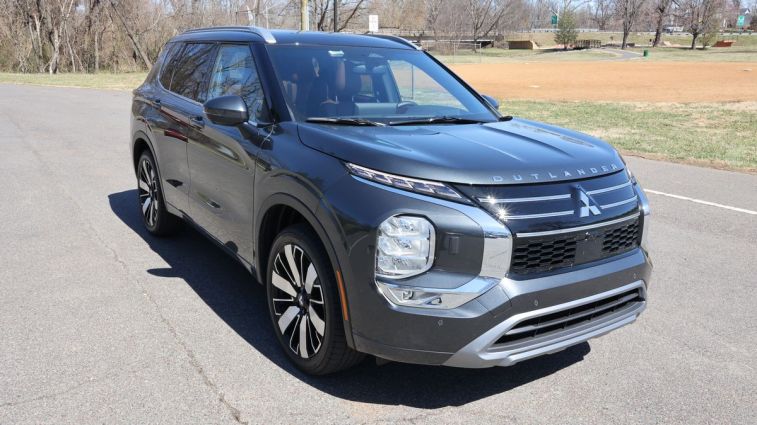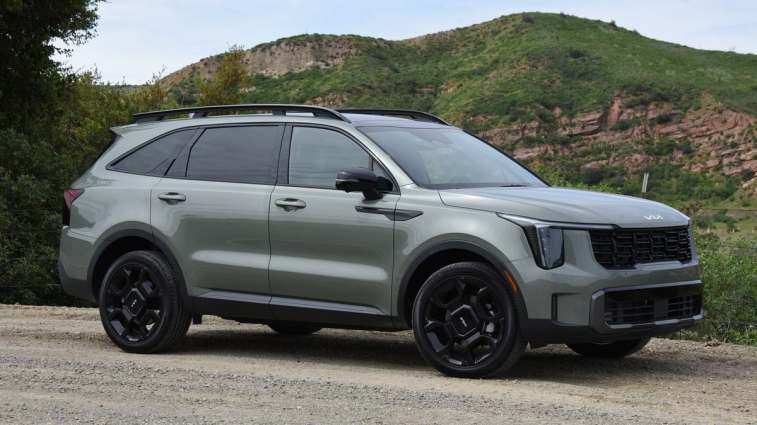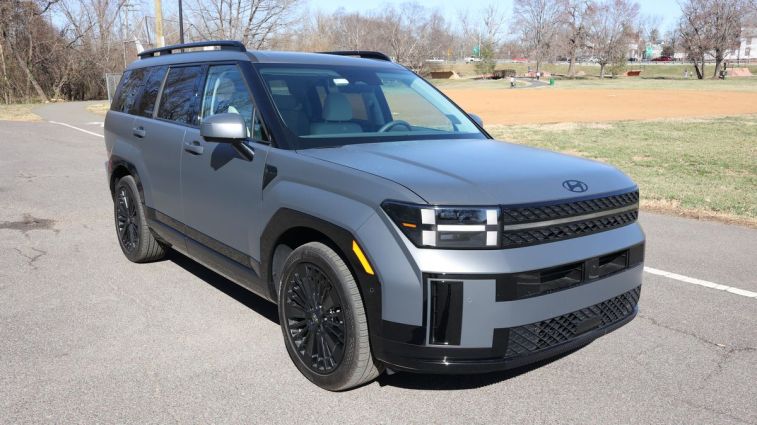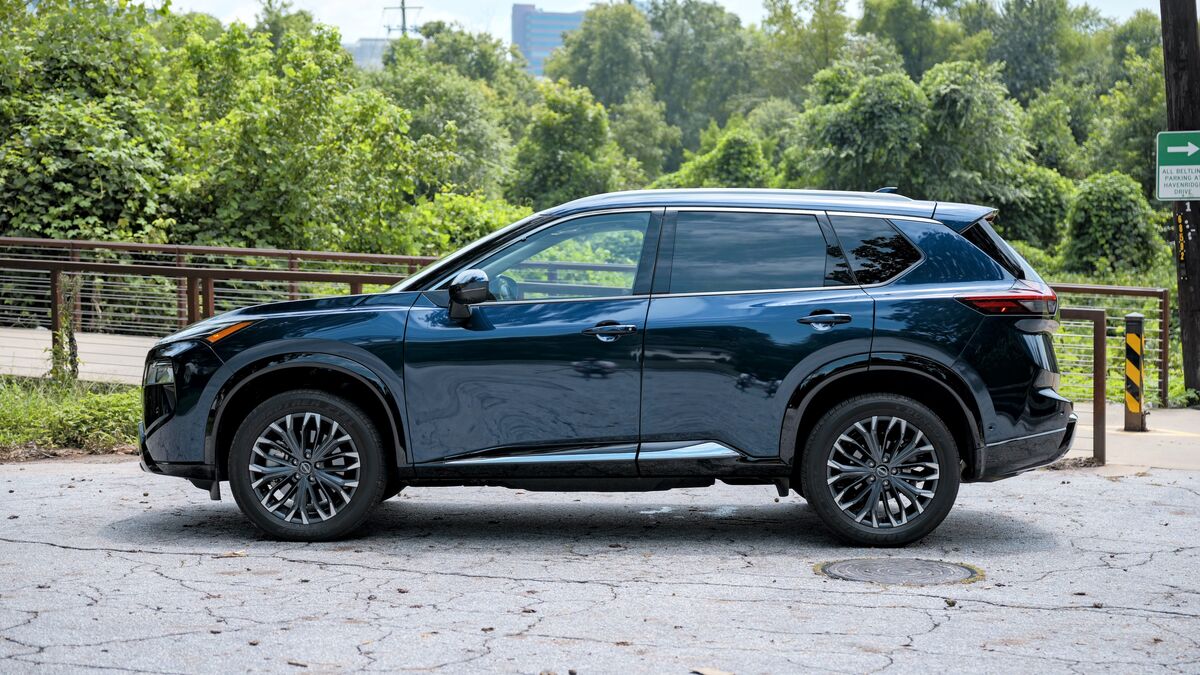If you’ve spent any time on any road at any time in the past 20 years, you know SUVs have proliferated like rabbits in spring. It’s little wonder that the variety of choices for today’s SUV shoppers has also increased exponentially. Case in point: Among the legion of compact and midsize SUVs to choose from, there are now several options for a class that sits between those two.
These vehicles combine the smaller dimensions of a compact SUV yet bring a big advantage usually found only in larger models: three rows of seats. These in-betweeners also tend to split the price difference between compact and midsize SUVs. Goldilocks would be proud.
We rounded up three of the best examples of this class – the 2025 Hyundai Santa Fe, 2025 Kia Sorento, and 2025 Mitsubishi Outlander – to see how they compare. During a week of testing in Virginia and beyond, we drove them hundreds of miles, evaluated their technology, experienced their features, and, yes, even limbered up our bodies to see if adults could actually sit in their third-row seats. Here’s how they fared.
Third Place: 2025 Mitsubishi Outlander

Taking bronze in our evaluation is the Mitsubishi Outlander, but for some buyers it might just be golden. Specifically, shoppers looking for a compact SUV that can seat up to seven in a pinch, and the most affordable new 3-row SUV you can buy.
As categories go, unlike the other two SUVs in this comparison, the Outlander still fits squarely in the compact SUV realm. And for 2025, it is now the only compact SUV with three rows of seats (the Volkswagen Tiguan offered that in the past, but no more for 2025). In addition to being slightly smaller, thus more nimble and parkable, the 2025 Outlander also has a lower starting price ($31,535) than its larger peers in this contest. This puts the Outlander in a special position as a compact SUV that just might save the day – or at least an extra trip – when your elementary-age kids want to bring a friend or two along.
That 3-row/7-passenger seating is an X factor, to be sure, but it’s hardly the only perk of the Outlander, which has just been refreshed for the 2025 model year. The updates include styling revisions to the interior and exterior, a retuned suspension feel, and a standard Yamaha premium audio system. The Outlander remains motivated by a 181-horsepower 4-cylinder engine linked to a continuously variable transmission (CVT) and can be had with either front-wheel drive (FWD) or optional all-wheel drive (AWD). We should note a plug-in hybrid powertrain is also available in the form of the Outlander PHEV model.
Our dazzled-up test model cost just under $46,000 and included premium amenities like diamond-stitched leather upholstery, a 12.3-inch digital instrument cluster with head-up display, a 12.3-inch touchscreen, heated/ventilated front seats, a heated steering wheel, and a new Yamaha audio system.
Our editors liked the interior, especially the little touches like dual pockets on the back seats, the crisp graphics of the instrument cluster, and the aforementioned Yamaha audio system.
On the road, we found the acceleration and passing prowess just adequate. At 181 hp, the Outlander lags the power output of rivals like the Toyota RAV4, Honda CR-V, Kia Sportage, and Hyundai Tucson, which will also never be loaded with more than five people.
Yet in shuffling one, two, or even four people down the road, the Outlander was fine, and its driver-assistance features, such as adaptive cruise control with lane-keeping assist, worked well. Also notable is Mitsubishi’s excellent warranty. Like the other two contenders here, Mitsubishi covers the powertrain for 10 years/100,000 miles.
As stated before, the Outlander’s X factor is its ability to squeeze seven seats into a compact footprint. The caveat is that, with third-row legroom of a mere 18.7 inches, seating in the last row will be a literal squeeze for all but the smallest of humans. Most buyers will likely leave the rearmost seats folded and use them only in carpool emergencies. If you need a bit more – of everything – without much more of a hit to your wallet, read on.
Learn more about the 2025 Mitsubishi Outlander in our Expert Review
New 2025 Mitsubishi Outlander Prices
|
Retail Price
|
Fair Purchase Price (92620)
|
|||
|---|---|---|---|---|
$31,490 |
$29,794 |
|||
$34,890 |
$32,861 |
|||
$39,790 |
$37,862 |
|||
$40,790 |
$38,865 |
|||
$45,940 |
$43,215 |
Second Place: 2025 Kia Sorento

As all-arounders go, it’s hard to go wrong with the Kia Sorento. Here’s a smallish SUV that does just about everything right and then surprises you with more.
Among our contestants, the Sorento offers the widest breadth of models to choose from, making us almost run out of fingers counting them all. For the record, the number is eight, from the value-oriented LX (starting at $33,405, less than $2,000 more than the Outlander) running up to the X-Pro SX Prestige ($48,805) like the one we tested. The Sorento’s choices don’t end there. It can be had with two different gasoline engines, including a turbo model with 281 hp, or as a hybrid or plug-in hybrid. The Sorento lineup is like that box of crayons you had as a kid; there will surely be a hue for you.
All Sorento models have three rows of seats, but depending on trim, they can seat seven with a middle-row bench seat or six thanks to dual captain’s chairs in that row.
Even though the Sorento is technically the oldest in this group, with this generation debuting for the 2021 model year, constant updates keep it feeling fresh and spiffy, the most recent being a 2024 mid-cycle refresh. Consider its standard 12.3-inch touchscreen display, available 12.3-inch digital instrument cluster, and features we’ve come to love, such as the Blind-Spot View Monitor with real-time video displayed in the instrument cluster, available hands-free tailgate, and all the other now-expected niceties like climate-controlled seats, premium audio, and 360-degree surround cameras.
On the road, we loved the eagerness of the 281 horses powering our Sorento test model. Getting up to speed and passing slower vehicles on Virginia’s windy two-lane roads was never a concern with this potent engine, and we like that, unlike the Outlander, the Sorento uses a traditional 8-speed automatic transmission instead of a continuously variable transmission. And even with the chunkier tires in our off-road-oriented model, cabin noise remained quiet enough to have a deep conversation about how to create the best automotive content on the planet. We hope you agree with the results.
Kia’s driver-assist systems remain among the best you can buy, and we let the Sorento chauffeur us for mile after mile with its Highway Driving Assist 2 system powered on (while always keeping hands on the wheel, mind you).
The Sorento’s interior is very comfortable overall. And hey, if you like your gear shifter substantial and tall in the central console, it’s the only one in this comparison with that setup (the Outlander’s is more of a nub, while the Santa Fe’s is a stalk attached to the steering column). As for the Sorento’s third row, while pretty tight with 29.6 inches of legroom, it is at least bearable for adults on shorter trips.
Learn more about the 2025 Kia Sorento in our Expert Review
New 2025 Kia Sorento Prices
|
Retail Price
|
Fair Purchase Price (92620)
|
|||
|---|---|---|---|---|
$33,405 |
$31,857 |
|||
$36,305 |
$34,604 |
|||
$39,505 |
$37,870 |
|||
$43,105 |
$41,559 |
|||
$43,205 |
$41,098 |
|||
$44,905 |
$42,789 |
|||
$47,805 |
$45,476 |
|||
$48,805 |
$45,907 |
First Place: 2025 Hyundai Santa Fe

The Santa Fe entered a new generation just last year, and what a makeover Hyundai’s longest-running SUV received. We reckon you’ve already seen these on the road and thought to yourself, “Well, that is a fine-looking new Range Rover.”
Yes, gone are the Santa Fe’s curves, replaced by a blocky, buffed-up design that yields benefits both outside and in. And yes, we know, at least at the rear, the looks are polarizing. It’s like that for a reason, and the rationale is all about space. At its world premiere, Hyundai’s designers told us they actually started with that huge, wide-opening tailgate so the Santa Fe could be used not only as a vehicle but as a lifestyle enhancer for tailgating and, yes, even car camping.
Space simply abounds in the Santa Fe, so much so that it feels nearly as roomy as its Palisade bigger brother. The cabin is also open and airy thanks to touches ranging from the aforementioned steering column stalk shifter to panoramic roof windows. And if you’re a tall driver, the Santa Fe might just be your new favorite vehicle. During testing of our even broader group that included 3-row midsize SUVs, the Santa Fe still had the most front legroom at 44.4 inches and copious headroom at 41.1 inches. So go ahead, stretch out.
Being the freshest model of this trio also shows in the tech and amenities Hyundai ladled into the Santa Fe. As kin to the Sorento (Hyundai and Kia are corporate cousins and share many technologies and parts), the Santa Fe also has goodies like Blind-Spot View Monitor, the ability to remotely park itself while you stand outside the vehicle (cool party trick!), and excellent driver-assist technology.
Yet it also has class-exclusive features like a UV-C sanitizing compartment that can zap the nasties on phones and toddler toys alike, a dual wireless phone charging pad, and even an available “Relaxation” driver seat that reclines and has a bottom leg support feature that extends when the car is parked. It might just become your vehicular sanctuary while the kids are at soccer practice.
As with the Sorento, the Santa Fe offers several trims to choose from. Standard on the Santa Fe is a 2.5-liter turbocharged 4-cylinder making a heady 277 hp. That means even the least-expensive Santa Fe SE ($35,775) doesn’t want for power. We’ve driven several turbo Santa Fe models and can attest to that.
For this test, we had the Santa Fe Hybrid in topline Calligraphy form with all-wheel drive, which retails for close to $50,000. The hybrid powertrain marries a smaller turbo 4-cylinder engine and a battery-fed electric motor. Total horsepower is a respectable 231, and torque is a more-than-respectable 271 lb-ft. Yet, the Santa Fe Hybrid earns up to 36 mpg combined in front-wheel-drive form or 34 with all-wheel drive. That’s impressive for a 3-row SUV.
On the road, we found this power played out well, with one slight caveat. When starting, the Santa Fe defaulted to its Eco mode – it’s a hybrid, after all – and we found throttle response muted for our taste. The quick and easy remedy is to put it in Sport mode, which pepped things right up and still delivered commendable fuel economy.
By now you can probably guess we liked the Santa Fe’s rearmost row the best, too. With 30 inches of legroom, it was the best in our group. And while that’s still snug for adults, it’s totally acceptable for kids.
And there you have it: Three non-traditional 3-row SUVs that aren’t too big, and not too small. Each of these three bears brings its own traits to the table, and we hope this comparison will help you find your own Goldilocks-approved model among them.
Learn more about the 2025 Hyundai Santa Fe in our Expert Review
New 2025 Hyundai Santa Fe Prices
|
Retail Price
|
Fair Purchase Price (92620)
|
|||
|---|---|---|---|---|
$35,795 |
$33,704 |
|||
$38,295 |
$35,681 |
|||
$42,445 |
$39,996 |
|||
$45,195 |
$42,906 |
|||
$48,345 |
$45,677 |







